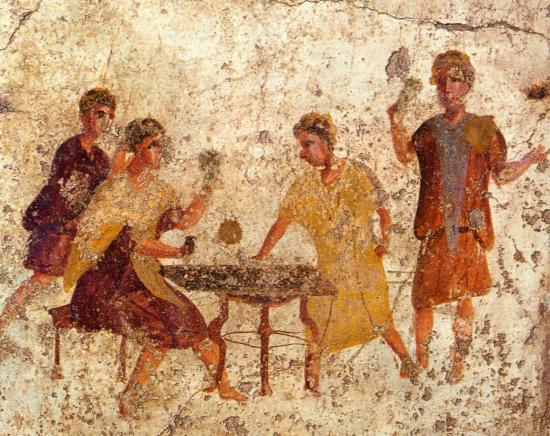PART.2
Dice games in antiquity were of two main forms: just tossing the things, or board games involving pieces moved according to the dice throws.
 Attic amphora by Exekias depicting Achilles and Ajax playing a board game during the Trojan War Jakob Badagard
Attic amphora by Exekias depicting Achilles and Ajax playing a board game during the Trojan War Jakob Badagard
The ancient board games typically featured 36 squares marked with symbols such as squares, leaves, letters, and crosses.
The dice themselves have not changed all these millennia: they had and still have six sides. In both dice and board games, usually three dice were thrown. The luckiest throw was three sixes. Fines were levied or pieces moved backward if the results were ones - snake eyes.
A sign in the ruins of a tavern near the praetorian camp said, “Good food and gambling within.” Tables have also been found with wording inscribed on them: “Make room for better players.”
Sports betting was a flourishing institution as well. Horse races and gladiator bouts provided the perfect occasions for that predilection.
But even in the days of yore, gambling went hand in hand with cheating. In Pompeii, for example, archeologists found convincing proof of the existence of loaded dice. Graffiti on a Pompeii wall boasts, “I am skilled enough to win without cheating.” (As Pompeii graffiti went, that was pretty innocuous).
Elsewhere in Pompeii, somebody painted a cartoon lampooning gamblers on the floor of a tavern. The first image shows two men sitting on chairs, with a game board on their knees. The first man, who had thrown the dice, says “Exsi” (I am out). The second man is pointing and saying, “Non tria dv as est” (not three points, but two). In the second picture, the men are standing up, apparently disputing the score, but the tavern keeper steps in: “Itis foris rixsatis” (Leave my place if you want to fight).
 Dice players. from the Osteria della Via di Mercurio, Pompeii Wolfgang Rieger, Wikimedia
Dice players. from the Osteria della Via di Mercurio, Pompeii Wolfgang Rieger, Wikimedia
Traces of the original Carthaginians
Aside from the excavation of the spectators rank itself, the archaeologists dug two other trenches within the monumental circus. One was to investigate the forerunners of the circus: the buildings that had been torn down to build it in the first place. One seems to have been a necropolis with impressive mausoleums dating from the relatively earlier Roman period.
Others were older, Punic in origin – built by the original Carthagians, who trace their origins to the Phoenicians from the Near East mixing with the local Berber tribes.
The area that was later to become the circus arena had undergone multiple reincarnations beforehand, having served in artisanal and economic activities.
There, the excavators discovered a posthole building, with a cut used to hold a surface timber or stone. This year the archaeologists managed to date this edifice to the Punic period, says Dr Iván Fumadó Ortega, the project head for the Punic era, adding that it was the first structure of its kind found at Carthage.
"We think that the structure, using cavities in the natural rock covered by wooden roofs, probably served a craft that used liquids in large quantities, maybe dyeing or tanning," Ortega added. Perhaps we will know more about this home, and about the interment of gambling fiends in the bleachers, after further excavations next year.